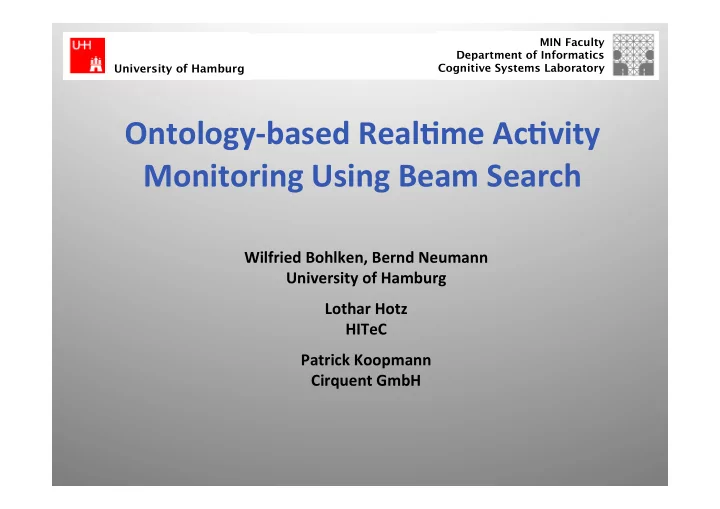

MIN Faculty Department of Informatics Cognitive Systems Laboratory University of Hamburg Ontology-‑based ¡Real0me ¡Ac0vity ¡ Monitoring ¡Using ¡Beam ¡Search ¡ ¡ ¡ ¡ ¡ ¡ ¡ Wilfried ¡Bohlken, ¡Bernd ¡Neumann ¡ ¡ University ¡of ¡Hamburg ¡ Lothar ¡Hotz ¡ ¡ HITeC ¡ ¡ Patrick ¡Koopmann ¡ Cirquent ¡GmbH ¡ 1 ¡
Ac0vity ¡Recogni0on ¡has ¡Numerous ¡Applica0ons ¡ Generic ¡architecture ¡for ¡scene ¡interpreta0on? ¡ 2 ¡
Scope: ¡ ¡Knowledge-‑based ¡ ¡ Scene ¡Interpreta0on ¡ scene ¡descrip0on ¡ "high-‑level ¡interpreta0on" ¡ ontology ¡ scene ¡interpreta0on ¡ system ¡ scene ¡models ¡ scene ¡geometry ¡ sta0c ¡objects, ¡tracked ¡objects ¡ "low-‑level ¡evidence" ¡ par0ally ¡recognised ¡ ¡ object ¡classes ¡ low-‑level ¡image ¡(sequence) ¡analysis ¡ 3 ¡
AircraT ¡Turnaround ¡Monitoring ¡ • ¡ ¡Recogni0on ¡of ¡mul0-‑object ¡ac0vi0es ¡such ¡as ¡ ¡-‑ ¡AircraT ¡Arrival ¡Prepara0on ¡ ¡-‑ ¡Passenger ¡Ramp ¡Mo0on ¡ ¡-‑ ¡Unloading ¡ ¡-‑ ¡Loading ¡ ¡-‑ ¡Refuelling ¡ ¡-‑ ¡AircraT ¡Departure ¡ ¡ • ¡ ¡Recogni0on ¡of ¡complete ¡turnarounds ¡ ¡-‑ ¡Monitoring ¡of ¡temporal ¡constraints ¡ ¡-‑ ¡Monitoring ¡of ¡unusual ¡ac0vi0es ¡ ¡ • ¡ ¡Large ¡variability ¡of ¡subtasks ¡and ¡turnarounds ¡ ¡ • ¡ ¡Large ¡number ¡of ¡unrelated ¡ac0vi0es ¡ ¡ • ¡ ¡Uncontrolled ¡environment, ¡difficult ¡low-‑level ¡image ¡analysis ¡ ¡ 4 ¡
Requirements ¡for ¡a ¡ ¡ Generic ¡Solu0on ¡ • ¡Incremental ¡real-‑0me ¡recogni0on ¡ Parallel ¡processing ¡of ¡mul0ple ¡par0al ¡interpreta0ons ¡ • ¡Preference ¡measure ¡for ¡resolving ¡ambigui0es ¡ Context-‑dependent ¡probabilis0c ¡ra0ng ¡ ¡ ¡ • ¡Image ¡analysis ¡for ¡uncontrolled ¡real-‑world ¡domains ¡ Dealing ¡with ¡missing ¡and ¡erroneous ¡evidence ¡ • ¡Knowledge-‑based ¡architecture ¡with ¡reusable ¡knowledge ¡base ¡ OWL-‑DL ¡ontology ¡with ¡SWRL ¡rules ¡ 5 ¡
Related ¡Work ¡ • ¡Badler ¡1975 ¡ ¡(conceptual ¡descrip0ons ¡of ¡object ¡mo0ons) ¡ • ¡Neumann ¡1989 ¡ ¡(natural ¡language ¡descrip0on ¡of ¡of ¡traffic ¡scenes) ¡ • ¡Rimey ¡1993 ¡ ¡(Bayesian ¡networks ¡for ¡vision ¡control) ¡ ¡ • ¡Nagel ¡1999 ¡ ¡(situa0on ¡graph ¡trees) ¡ • ¡Thonnat, ¡Brémond ¡2007 ¡(scenario ¡recogni0on) ¡ • ¡Zhu ¡& ¡Mumford ¡2007 ¡ ¡(stochas0c ¡grammar ¡of ¡images) ¡ • ¡Moeller ¡2010 ¡ ¡(logic-‑based ¡media ¡interpreta0on) ¡ ¡ => ¡ ¡ ¡recognising ¡hierarchical ¡composi0onal ¡structures ¡ ¡ 6 ¡
Represen0ng ¡Ac0vity ¡Concepts ¡ ¡ in ¡OWL-‑DL ¡ • OWL is a standardised ontology language - Definition of properties, aggregate taxonomies and partonomies - Knowledge editor Protégé in wide use • Powerful Description Logic reasoners support OWL-DL - Useful services for large high-level knowledge bases - No support for stepwise recognition - No support for constraint solving • Crisp relations - Fuzzy or probabilistic information cannot be represented • SWRL extension for rules - Awkward definition of quantitative constraints 7 ¡
Taxonomy ¡for ¡Turnaround ¡ Ac0vi0es ¡ ¡ ¡ ¡ ¡sub-‑class ¡ rela3on ¡ Upper model OWL-‑Thing ¡ Conceptual ¡Object ¡ Physical ¡Object ¡ Sta3c ¡ Primi3ve ¡States ¡ Composite ¡Events ¡ Mobile ¡ Arrival ¡Prepara3on ¡ Person ¡ Vehicle ¡ Vehicle-‑ ¡ Vehicle-‑ ¡ Inside-‑Zone ¡ Outside-‑Zone ¡ Unloading-‑And-‑Loading ¡ GPU ¡ Tanker ¡ Tanker-‑ ¡ Refuelling ¡ Domain ¡ Inside-‑Zone ¡ model ¡ Departure ¡ 8 ¡
Using ¡the ¡Protégé ¡Editor ¡ Concepts ¡are ¡defined ¡ ¡with ¡taxonomical ¡and ¡binary ¡rela0ons ¡(roles) ¡ 9 ¡
Composi0onal ¡Hierarchy ¡ sub-‑class ¡rela3on ¡ has-‑part ¡rela3on ¡ Turnaround ¡ Arrival ¡ Services ¡ Departure ¡ Arrival-‑ AircraU-‑ Services-‑ Services-‑ Services-‑ AircraU-‑ Prepara3on ¡ Arrival ¡ With-‑C ¡ With-‑R ¡ With-‑CR ¡ Leaves-‑ Arrival-‑Zone ¡ Services-‑ No3fica3on ¡ GPU-‑ AircraU-‑ Without-‑CR ¡ Posi3oned ¡ Posi3oned ¡ GPU-‑ AircraU-‑ Unloading-‑ Passenger-‑Boarding-‑ Passenger-‑Bridge-‑ Posi3oning ¡ Posi3oning ¡ Loading ¡ Prepara3on ¡ Leaves ¡ Unloading-‑ Loading-‑ Pushback-‑ Passenger-‑ Passenger-‑ Only ¡ Only ¡ Arrival ¡ Bridge-‑ Bridge-‑ Posi3oning ¡ Posi3oned ¡ Unloading-‑ And-‑Loading ¡ 10 ¡
Temporal ¡Constraints ¡in ¡OWL ¡ Monitoring service activities requires quantitative temporal constraints. Passenger ¡stairs ¡must ¡be ¡posi3oned ¡not ¡later ¡than ¡5 ¡minutes ¡aUer ¡ aircraU ¡arrival. ¡ A ¡GPU ¡will ¡stop ¡not ¡later ¡than ¡1 ¡minute ¡aUer ¡entering ¡the ¡GPU ¡zone. ¡ ¡ In OWL, quantitative constraints can only be represented using the rule extension SWRL or – in OWL 2 – using OWL-RL. SWRL rules have disadvantages: • Not elegantly connected to OWL classes • Reasoning with SWRL is undecidable (in general) 11 ¡
Example ¡of ¡Temporal ¡SWRL ¡Rule ¡ OWL ¡class ¡defini0on ¡of ¡ Visit ⊑ Composite-Event ⊓ a ¡vehicle ¡visi0ng ¡a ¡zone ¡ has-part1 exactly 1 Vehicle-Enters-Zone ⊓ has-part2 exactly 1 Vehicle-Leaves-Zone "Visit ¡begins ¡with ¡Vehicle-‑Enters-‑zone ¡and ¡ends ¡with ¡Vehicle-‑Leaves-‑Zone. ¡ ¡ ¡ Vehicle-‑Enters-‑Zone ¡and ¡Vehicle-‑Leaves-‑Zove ¡have ¡the ¡same ¡agent ¡and ¡zone, ¡respec0vely." ¡ Visit(?vis) ∧ has-part1(?vis, ?veh-enters) ∧ has-part2(?vis, ?veh-leaves) ∧ has-start-time(?vis, ?vis-st) ∧ has-finish-time(?vis, ?vis-ft) SWRL ¡rule ¡premise ¡ ∧ has-time-point(?veh-enters, ?veh-enters-tp) establishes ¡variable ¡ ∧ has-agent(?veh-enters, ?veh-enters-ag) names ¡ ∧ has-zone(?veh-enters, ?veh-enters-zn) ∧ has-time-point(?veh-leaves, ?veh-leaves-tp) ∧ has-agent(?veh-leaves, ?veh-leaves-ag) ∧ has-zone(?veh-leaves, ?veh-leaves-zn) → SWRL ¡rule ¡consequence ¡ ?vis-st = ?veh-enters-tp specifies ¡iden0ty ¡constraints ¡ ∧ ?vis-ft = ?veh-leaves-ft ∧ ?veh-enters-ag = ?veh-leaves-ag and ¡temporal ¡constraints ¡ ∧ ?veh-enters-zn = ?veh-leaves-zn ∧ ?veh-enters-tp ≤ ?veh-leaves-tp 12 ¡
Transforming ¡an ¡OWL ¡Knowledge ¡Base ¡into ¡ an ¡Opera0onal ¡Interpreta0on ¡System ¡ ¡ Interpreta0ons ¡ SCENIOR Jess Conceptual Jess ¡ Knowledge Base Rule ¡ Engine ¡ OWL + SWRL Conceptual Hypotheses Converter Knowledge Structures Java ¡ ¡ Handcrafting Base Annotated Constraint ¡ ¡ or Turnaround Solver ¡ Temporal Learning Sequences Constraint Net Probabilistic Templates BCH ¡ Aggregate Inference ¡ Descriptions Probabilistic Engine ¡ Aggregate Models Primi0ve ¡Events ¡
Genera0ng ¡Hypotheses ¡Structures ¡for ¡ the ¡JESS ¡Working ¡Memory ¡(1) ¡ Hypotheses ¡structures ¡provide ¡independent ¡interpreta0on ¡goals: ¡ • ¡Basis ¡for ¡predic0on ¡and ¡ranking ¡ • ¡Single ¡representa0on ¡for ¡mul0ple ¡or ¡alterna0ve ¡occurrences ¡ • ¡Certain ¡parts ¡may ¡be ¡marked ¡as ¡hallucinatable ¡ Loading-‑ Catering-‑ Refuelling ¡ Opera3on-‑FWD ¡ LeU-‑AFT ¡ Tanker-‑ Tanker-‑ Catering-‑ Loader-‑ Catering-‑ Loader-‑ Posi3oning ¡ Leaves ¡ Posi3oning-‑ Posi3oning-‑ Leaves-‑ Leaves-‑FWD ¡ LeU-‑AFT ¡ FWD ¡ LeU-‑AFT ¡ Tanker-‑ Posi3oned ¡ Catering-‑ Transporter-‑ Posi3oned-‑LeU-‑AFT ¡ Posi3oned-‑FWD ¡ Low-‑level ¡leaf ¡nodes ¡must ¡be ¡ instan0ated ¡by ¡evidence ¡from ¡ low-‑level ¡image ¡analysis ¡ 14 ¡
Recommend
More recommend